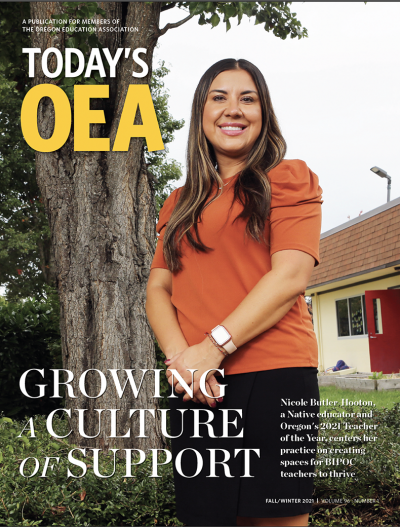As part of a transformative effort to ensure our members' voices drive our decisions, OEA has launched a comprehensive member engagement program based on one core philosophy: listening to our members. One-to-one meetings are the core of this plan as it is the most effective tool for member engagement. OEA has set an ambitious goal to conduct one-to-one meetings with at least 75 percent of our members and potential members over the next year. Our goal is to learn more about our members' stories – what keeps them showing up each day and what we can do to help them succeed.
We also want to learn whom they view as respected and trusted colleagues. Finding respected peers at every worksite to serve as the face of our union in the fight for quality schools and the wages, benefits and working conditions to be able to deliver on that promise is key to our success.
We also are doubling down on our outreach to early career educators. These members are the future of OEA, and we need to empower them to help set our priorities. Educators entering their careers right now have an incredible passion for the profession; they are craving an outlet to improve their practice and improve public schools. We are that outlet.
To date, nearly 40 local associations have set up Engage/listening projects in their locals. Our members are listening to each other’s stories and they’re building union goals based on what they hear from each other. While most locals conduct their own Engage Campaign, in some of the Engage efforts, member organizers from nearby locals volunteered to participate as member organizers. For example, listening teams from the Columbia River UniServ Council recently took part in an Engage effort in Hermiston. Members experienced their union’s support from area colleagues who took the time to listen to their stories.
Here are just a few testimonials that we’ve heard across the state:
Cindy Towers, Roseburg EA Secretary and Engage Team member shared, “The Engage brought us together in a way we hadn’t experienced before. Our secondary teachers listened to our elementary members and the elementary did the secondary. We realized how much we had in common. We shared our findings with members and the district. The district quickly responded to feedback with suggestions about professional development.”
Cindy Williams, Oregon City EA President said, “We were able to meet staff whom we hadn't spoken with in person before and our members appreciated the one-to-one interactions. This experience was well received by our OCEA Leadership team, members, and District Administration. We even heard 'Aren't you going to listen to our building?' from a couple of principals.”
Grants Pass ACE member and bus driver Becky Boone told us, “We felt comfortable having open and honest conversations. This was definitely a valuable experience that should continue throughout the Grants Pass ACE and the state.”
Rita Glass, incoming President of ASK-ESP in Salem said that although her local has yet to participate in the program, "I'm absolutely committed to connecting positively with ASK-ESP members. We want to visit as many members in the worksite as possible to listen to their hopes and challenges so that we can provide the best support possible."
The Engage program is on the move, and we'll be featuring participating locals in an ongoing series of stories in Today's OEA, starting with Astoria in this issue. If you haven’t yet participated in a listening program through your own local association, ask your local president about starting one up. If you'd like to become involved in an Engage listening team, contact Susan Crumpton, Assistant Executive Director of the OEA Union School (susan.crumpton@oregoned.org). Together, we are building our union: OEA Strong.
— Jim Fotter, OEA Executive Director
Over the span of about four hours during a professional development day, 15 members of the Astoria Education Association (AEA) engaged in a round of conversations with their colleagues in each of the four schools in Astoria (two elementary, one middle, and one high school). Their goal? In a single afternoon, to talk to 85 percent of the members of AEA about their experiences as educators and union members in the community. Four hours in to the listening project, and Astoria had become the newest participant in OEA’s Engage Program – a cornerstone of the statewide Association’s organizing efforts this past year. The Engage Program’s focus is simple, but powerful: set up as 1-to-1 conversations to allow listeners to fully hear what members’ experiences and hopes are without making an ask or request of them at the end of the conversation.
Matt Hensley, Astoria EA’s President and an 8th grade U.S. History teacher at Astoria Middle School, agreed to host the Engage Program in his local to build deeper ties with members across the district. Though he’s been serving as President for nine years, Hensley says there are still members, particularly newer teachers, who he’s yet to meet.
“I love the way we’ve done this program today because I was able to see a lot of our members face-to-face, which I don’t often get the opportunity to do,” Hensley said. “I want our members to feel like the union is important. Getting our members connected is the first step to that as we make this a regular part of our union culture.”
While each local association can develop their own series of questions for the conversations, the general format stays consistent from local to local. In Astoria’s case, the Engage program was guided by three principle questions:
- What has cultivated success in your work so far this year?
- What keeps you from doing your job as well as you want?
- Who among your peers in the building do you feel is the most trusted and respected?
In Astoria, teams of 3-5 “listeners” (mostly leaders of Astoria’s local association executive committee) were routed to a school where they did not teach or work – helping to ensure the authenticity of responses collected. The conversations were meaningful, but brief. Yet for some of the members – it was the first time they’d truly been engaged by their union, face-to-face.
After the conversations had wrapped, Engage leaders convened at a local brewery to debrief and reflect on what they heard. Sara Whelan, OEA's Statewide Organizing Coordinator, encouraged Astoria leaders to think about the responses they’d collected. “What stood out? What was surprising? What were the common themes heard that afternoon?”
At one of the elementary schools, the conversation focused on the depletion of classroom supplies due to funding. One teacher had spent over $1,000 out-of-pocket to fund student projects. The science lab was out of materials and low on equipment, leaving students without the ability to conduct science experiments for the remainder of the year.
At the middle school level, behavior problems seemed to be a top concern – especially given the middle and high school’s large class sizes. Teachers expressed frustration that behavior issues had not been adequately addressed.
High school teachers, particularly those identified as ‘singletons’ in their subject area, wanted stronger curriculum – and the time and resources to create it. Like their colleagues at the elementary level, high school teachers felt frustrated by the demands that state testing placed on their availability to teach students and the time it took to both prepare for and administer state tests.
One of the listeners expressed, “Over and over again, I heard that collaboration is what made our teachers successful. They wanted more time with their PLC’s (Professional Learning Communities) because time for collaboration, at least within their own discipline, was immensely supportive.”
Hensley noted that individual responses from non-members are important to hear, too. “I always tell people, you may not agree with everything that the union supports, because we are individuals and we all have different beliefs – but our strength in our profession comes from our engagement in the union.”
“No student is an island and no teacher is an island,” he said. “Our strength is built up in the union. We do what we do in our classrooms because the union is strong enough in this state and supports our growth. But, we have to do our part to keep it that way.”

